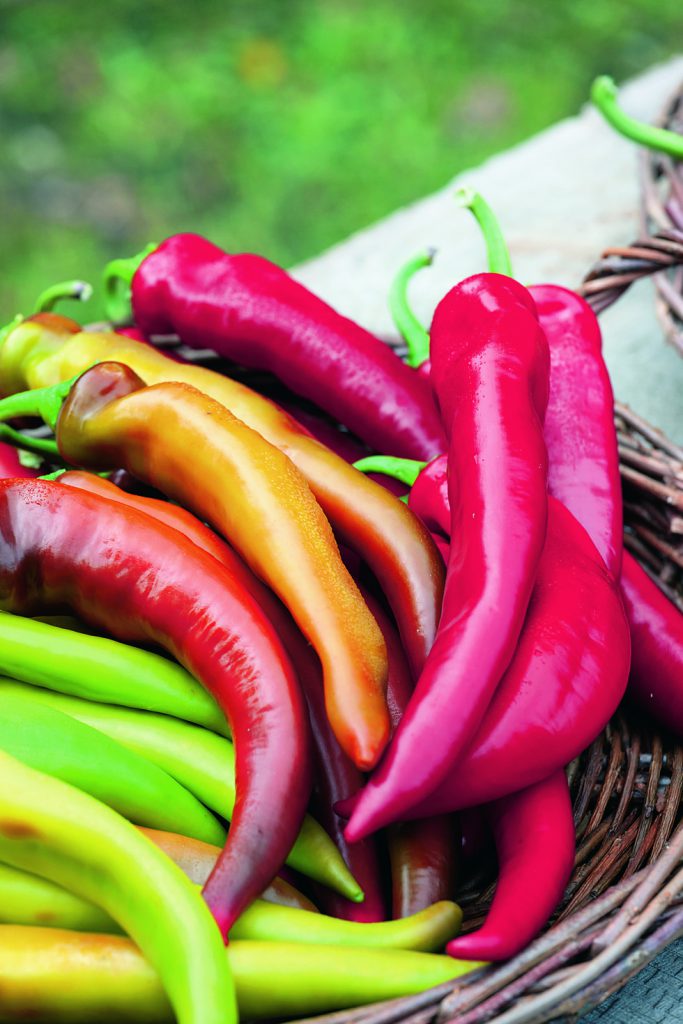As in trendy and award-winning, not necessarily spiciness, but there’s that too

ALL-AMERICA SELECTIONS
The semi-hot Hungarian Mexican Sunset wax pepper, a 2018 All-America Selections winner, changes color as it ripens.
Beautiful and brightly colored, hot pepper plants are a great addition to your garden, flower borders and even containers for easy picking.
Your biggest challenge is narrowing down your choices. Looking at the winners of All-America Selections (AAS, all-americaselections.org) can help you start. This nonprofit organization tests new edible and ornamental varieties nationally for their suitability to home gardens and containers. Several of this year’s pepper winners ripen earlier than other varieties—that is, they grow faster to maturity, which is an important consideration for our relatively short growing season in Wisconsin.
Grow a few cayenne peppers if you like Mexican, Cajun and Asian cuisine. They also add zip to any dips, stews and marinades. Your meals and garden will be brightened by the brilliant red and tasty fruit of Red Ember. This 2018 AAS winner is pretty enough for flower gardens or containers. You’ll be harvesting earlier and longer, providing more time to use and enjoy them.
For a mildly spicy option with the same great flavor, try Cayennetta. Its heat and cold tolerance makes it a great choice for Wisconsin.
If you like it even hotter, include a few habaneros in the garden. They add heat and flavor to jerk chicken, chili, jam and other recipes. For those who like the flavor of habanero, but can’t stand the heat, try Roulette habanero. It looks and tastes like a habanero in every aspect except it’s not hot. Roulette is the perfect solution for families with different heat tolerances.
Add a full spectrum of color to containers and small space gardens with the early ripening Hungarian Mexican Sunrise and Sunset wax peppers. The conical shaped fruit transition from green to yellow, then orange and red. The fruit can be harvested and eaten at any stage. But the longer it is on the plant, the better the flavor. Mexican Sunrise is semi-hot; Mexican Sunset is for those who like a bit more heat. Both can be eaten fresh, stuffed, baked, grilled or pickled.
Grow a few Aji Rico peppers to add heat with a hint of citrus to your dishes. Eat them fresh or cook into salsa and hot sauces. Control the heat with the number of seeds left in the fruit. The more seeds that remain, the greater the heat.
For dramatic size and good heat, try Giant Ristra. Roast them, use them fresh or string a few peppers together to dry and use throughout the winter. Don’t be fooled by its appearance. This 7-inch chili pepper looks like a sweet Marconi but has the spiciness of a cayenne.
Those who want to crank up the heat can try Emerald Fire. Not the hottest pepper on the market, but this jalapeno is certainly one to respect. The deep green fruit resists cracking and matures to red. Use them fresh, stuff with cream cheese, grill or can for later use.

ALL-AMERICA SELECTIONS
The miniature, mildly hot bell pepper Chili Pie.
If your taste lies on the other end of the heat spectrum start with the bell pepper Chili Pie and work your way to some of these hotter varieties. These miniature bell peppers are mildly hot when the fruit turns red. Be careful not to mix them in with your sweet bell peppers.
Heed this warning when growing and using any hot peppers. Clearly mark or better yet grow your hot peppers away from sweet peppers to avoid an unwelcome surprise. Keep your hands away from your eyes when working with hot peppers and wash them thoroughly when done.
Most importantly, have fun growing and using hot peppers in your garden, containers and meals. These beauties combine nicely with other vegetables, herbs and flowers to create stunning garden beds and containers. And their spicy flavor is sure to help you create memorable meals this summer.
Melinda Myers is based in Wisconsin and has written more than 20 gardening books, including Small Space Gardening, and hosts the nationally syndicated Melinda’s Garden Moment TV & radio segments. Myers is a columnist and contributing editor for Birds & Blooms magazine and was commissioned by AAS for her expertise. For more articles, see melindamyers.com.




